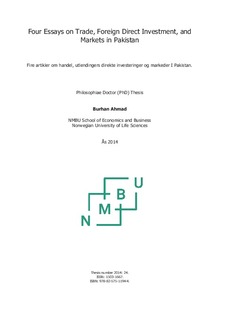| dc.description.abstract | This dissertation seeks to study aspects of economic growth and development in Pakistan that have been pursued through enhancing commodity-specific exports, attracting foreign investment and improving the functioning of commodity markets. It is comprised of four research articles. Article 1 investigates the factors affecting commodity exports and identifies markets that have unexploited export potential. Rice exports from Pakistan during 1991-2010 are taken as the example and studied using panel data and techniques. It is found that Pakistan's economic growth, importers income, export prices, specialization, the currency exchange rate and transactions costs are the major factors affecting rice exports from Pakistan. A high unexploited export potential is also found in 49 export markets out of the 92 countries. The second article measures the economic and institutional determinants of Foreign Direct Investment (FDI) inflows into Pakistan and answers why FDI has been low and uneven despite investment-friendly policies during 1996-2010. Pakistan’s market size, governance, infrastructure, human capital, favorable business environment and income and governance of the foreign investors are the major factors responsible for attracting foreign direct investment in Pakistan. Low economic growth, bad governance, and a lack of skilled human capital are possible reasons for low and variable net FDI inflows. Article 3 answers the question whether commodity markets such as rice are integrated domestically and with the international markets. It also examines the effects of government policies on the extent of market integration employing time series data and techniques. It is found that Pakistan’s domestic markets are integrated domestically and with the international markets. The price support policy abolition seems to have contributed to greater domestic integration, while the subsequent export policies seem to have decreased the extent of Pakistan’s integration with the international markets. Article 4 examines the spatial differences in volatility across regional rice markets of Pakistan using time series data and techniques. Volatility clustering is found in all markets. Volatility and its persistence differ spatially reflecting differences in infrastructure that make some regions more exposed to risk. A positive association of volatility across markets is found, and its degree is reviewed in light of market geography and infrastructure. Overarching conclusions of this dissertation are the following: Higher productivity and economic growth, specialization, developing infrastructure and human capital, and improving institutional quality are the important factors that can contribute to the economic development of Pakistan. Investments on education and research and development, bringing in technology, improving infrastructure and institutional quality and implementing bilateral trade and investment agreements would strengthen the foundation for economic development of Pakistan through accelerating exports, foreign direct investment and improving the functioning of markets. | |
